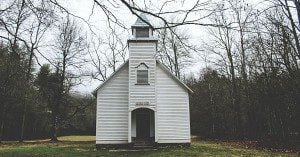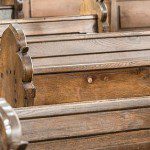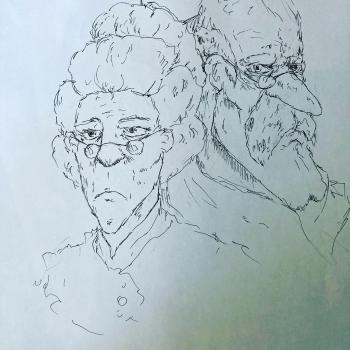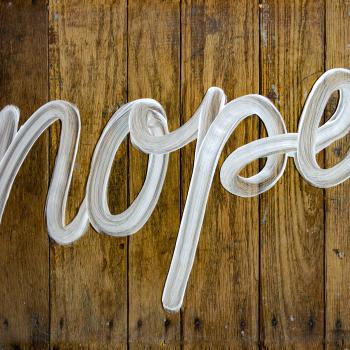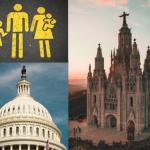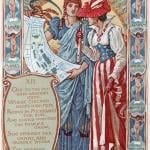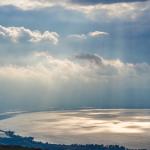The Methodist Church near the Old Good Shepherd (Now Islamic Awareness Center) recently closed. I passed by and marked its death, yesterday, on my way from the shops on the Southside, through the once fine but now shabby neighborhood along that stretch of road, all the way to the New Good Shepherd. Another hundred year old church comes to a quiet, unremarkable end.
It had been a work of first importance, so long ago. The Southside was settled even before a good bridge joined it with the main part of the town. As houses and business went up, so did churches—neighborhood churches. And so within four blocks of each other there were three —Catholic, Methodist, and Episcopalian. Wending away towards the new Good Shepherd you find an old stalwart Baptist church, and going the other direction, back towards the hospital, you will find a Presbyterian, an Orthodox Armenian, and another, much stricter Baptist.
All these churches in such close proximity to each other, less the stricter Baptist, used to meet together several times a year in an ecumenically friendly way to do charitable work, pool resources for a vacation Bible school, and to celebrate a Thanksgiving service. Without going too deeply into theology, a shared belief in a trinitarian God and the atoning work of the Son, along with an ability to say the creeds without guile, made meeting together profitable and encouraging.
After all, this “city,” but really town, like so many across the northeastern rust belt, isn’t what it used to be when all these churches were originally built up in brick, mortar, hand crafted stain glass, and belief. They squat on the corners of streets once bustling with industry and hope. Now the disconsolate poor meander by with shopping bag laden strollers. Rusting cars shudder along the crumbling roads. Occasionally a young person in an expensive, shiny car will drive by, music blaring, looking for anyone interested in his wares. A middle aged thin man crouches on the sidewalk, dizzy, disoriented, hungover. A nice older retired lady stands peering in the window of the post office, quizzically disappointed about the severely curtailed hours.
The Methodist church closed because there weren’t enough people who wanted to go there any more. The church sign has been denuded, emptied of the useful welcoming information that failed, decade after decade, to entice anyone to come in and sit in its beautiful, well worn pews, to learn anything in its cunning and carefully crafted Sunday school rooms, to make a pot of coffee in its well organized kitchen. Now, two stark realty signs announce its passing from life to death, one there and the other at the old well endowed parsonage next door. But that is the only indication of any kind of change. I have often driven by in the last decade, and I rarely have ever seen anyone go in or go out, except when I happened to arrive on purpose for Thanksgiving.
As the Southside churches tried their best to both ignore and stave off steep decline, the Ecumenical Council, by the persistent encouragement and guidance of the representative from Good Shepherd, attempted to get the churches to agree to a very basic statement of doctrine. All the churches except the Methodist agreed. That year, the pastor—for they are moved around between five and seven years—said she did not want to do anything so exclusive that it would be impossible for the Muslim Imam, who had lately taken over our property, to join in. The kind older ladies who made up the council, and our younger and long suffering one, sat silent in open mouthed disbelieving wonder.
And so the council did not exist any more in the usual way. The Baptists and Presbyterians were not, after very much longer, able to send representatives, much less afford full time pastors, though the robust Catholic Church on the opposite corner of the Old Good Shepherd continues to thrive. And we farther down the road keep on in our humdrum way, tracing our way through the scriptures, mowing the lawn, installing security cameras and better lighting so that people feel safe and comfortable, and trying, always, to make eye contact with the people who walk back and forth across our parking lot, but who are only very rarely persuaded to come in.
There we are, in a neighborhood, which is where people live in houses set back from quiet unremarkable streets, their lawns and gardens of varying elegance or shabbiness. They come and go. They are not very different from people a hundred years ago. But one thing they don’t seem to want or need is a church.
Or do they? That Trinitarian God, after all, so loved the world—the rust belt poor, the depressed pensioner, the young white native Binghamtonian who dons the hijab and turns her face toward Mecca, the tired, single, African American lady and her four children walking to the Weiss, the Cuban teenagers careening around on their bikes and climbing on the roof of our shed, the many children dropped off in the daycare opposite Good Shepherd’s front door—that he sent the Son in poor humility. He did not come to raise our economic status, to make our lawns prettier and our cars less clunky. He did not come to solve our heroine problem or build up the family again. He came to save us from death. From death that goes on forever.
That still, quiet, empty sanctuary, sitting there, as so many do around this town, is a haunting and devastating failure. We are living in ourselves the death of belief, and of hope. The only thing that can save us is the one who came to do that very thing. If you want to live, go to church, listen to the words of the one who is life, but try your best to take someone with you.

